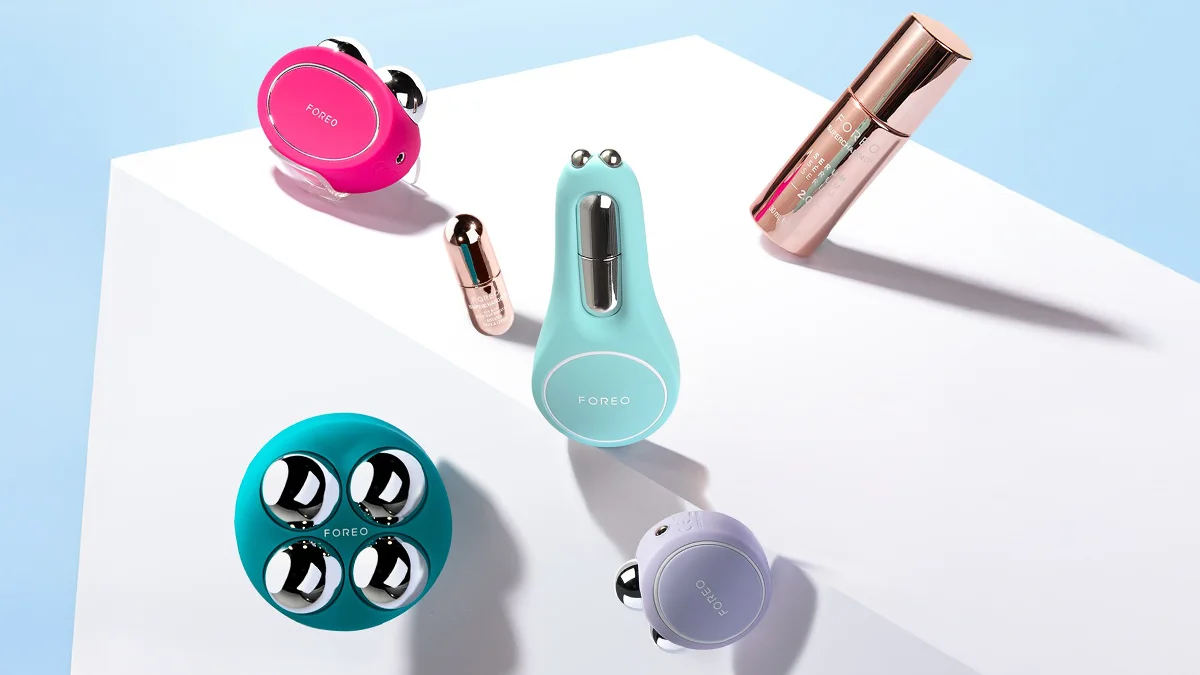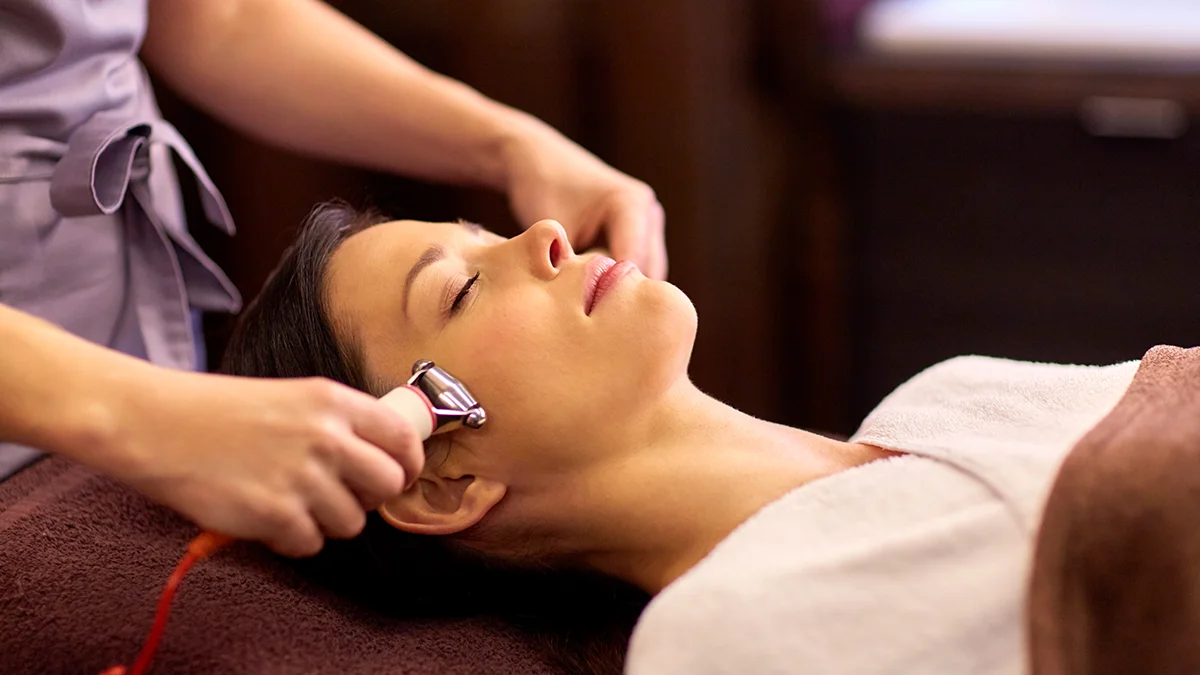13 min read
Tech Truth Time: Can Microcurrent Make Wrinkles Worse?

Well, you've heard the buzz about the huge success of microcurrent facials and the lifting and toning effects of the therapy, but you may also wonder if the candid whispers of microcurrent side effects and anecdotes hold some truth: Could microcurrent cause wrinkles to worsen? Or is it a try to discredit a well-tolerated, safe, and non-invasive anti-aging treatment you can do in your own home? Could it perhaps depend on how you use the technology?
Stats say that nearly half of users share these concerns about using microcurrent, so this is why we are here today - to unpack the science behind microcurrent therapy, hear from experts, evaluate its real impact on wrinkles, and offer smart guidance on the ideal way to use microcurrent in your skincare routines.
Why Does Microcurrent Work on Wrinkles?
A typical lightning flash is about 300 million Volts and 30,000 Amps. In comparison, currents in your home are about 120 Volts and 15 Amps, while microcurrent facial devices usually stay under 1000 µA (microampere: one-millionth of an ampere).
What is microcurrent? An ultra-gentle electrical current that mimics our body's own bioelectric signals, which run our entire body, brain, heart, and muscles. How does microcurrent help with wrinkles? It stimulates ATP (cell energy produced in the mitochondria) production, energizes fibroblasts (which secrete collagen proteins), and encourages elastin creation. When we talk about microcurrent for wrinkles, we refer to using recurring microcurrent treatments in the office or using at-home microcurrent facial devices to reeducate muscles below the skin, enhance skin tone, and reduce fine lines by promoting blood circulation and protein synthesis in the treated areas.

Although used in ancient times for purposes like pain management (think electric eels), the restorative function of microcurrent was actually the first use of modern machines in medical science in the 1980s. These machines were used to help recover the drooping muscles of patients with facial nerve damage due to Bell's Palsy, unexpectedly leading to improvements in skin tone and texture and a whole new aesthetic branch splintered from the medical uses of electric currents.
Microcurrent works on reducing wrinkles because it is not just a surface treatment but goes right down to the muscle and solves the skin concerns on the cellular level, speeding up the processes of recovery and restoration of skin and muscle. It is natural for the cells to slow down their function and turnover as we age, and this results in them not being able to fix all of the damage that happens daily, and we start seeing some sag and fine lines appear on our faces. All cells, including skin cells, keep churning, and you'll have a new face (about) every month while you're young. This process can take up to 84 days for older individuals. Getting older is a privilege not given to all, and we should treat it with dignity and respect, but that doesn't mean we cannot have a say in how we age.
Science Says It Works
The studies confirm the efficacy of microcurrent on wrinkles, lines, and improving skin state in general. One of the most impressive findings comes from a study conducted by the University of Washington's Psychology Dpt and Emil Y. Chi, Ph.D. The research was heavily focused on the impact of microcurrent on skin tissue and concluded the following:
- 35% increase in peripheral blood circulation
- 45% increase in the number of dermal elastin fibers, with a doubling in their average length
- 35% rise in the number of blood vessels
- 10% increase in collagen thickness
- 28% enhancement of lymphatic drainage
The study demonstrated that microcurrent is excellent in stimulating angiogenesis (that's the creation of new blood vessels) to boost local blood flow. More fresh blood means skin cells getting plump and happy with oxygen and nutrients while accelerating toxin removal. All of these findings are why microcurrent therapy supports skin renewal and health.
A randomized, controlled trial (we love those) published in the Journal of Cosmetic Dermatology (2012) by Kavanagh et al. also provided quite robust evidence to confirm the "non-invasive facelift" claims:
- 108 women (ages 32–58) used a facial microcurrent device for 20 minutes a day, five days a week, in a period of 12 weeks.
- ≥80% of participants reported improved facial firming, tone, and lift, compared to less than 5% in the control group.
A randomized clinical trial in Life Science Journal (2012) led by Saniee et al. included 30 young women under age 45. They did a 20-minute microcurrent facial treatment daily for 30 sessions, and the subsequent evaluation concluded:
- 18.37% reduction in forehead wrinkles immediately after treatment, increasing to 21.18% at one-month follow-up.
- Nasolabial and mouth-area wrinkles improved by 7.6% after treatment and 5.9% one month later.
- Patient satisfaction was over 70%, and results were stable a month post-treatment
Truth or Lie: Can Microcurrent Make Wrinkles Worse?
Who would have ever thought that the elephant creasing your rug there in the middle of the room could be the width of a crow's feet line, that angry 11s stamped onto your mid-brow, or the traitorous tiny lines radiating from the mouth? Let's walk up to him and ask: Can microcurrent make wrinkles worse?
If you expected a simple yes-no binary answer, don't. The truth here is somewhere in the gray area, just as nothing in life is completely black or white. Tools are not good or bad in themselves. Their utility depends on how we choose to use them. The poison or a cure is also in the dosage (long live hormesis = what doesn't kill you makes you stronger), and laymen would do close to nothing if only in possession of the master's tool, but not the know-how on its application. So, the answer to microcurrent making wrinkles better or worse is layered and contextual. Can microcurrent make wrinkles worse? It depends.

Use of microcurrent for wrinkles pros
There seems to be clinical evidence that controlled and consistent face stimulation with the appropriate intensity of microcurrent (the aforementioned under 1000 µA range) can strengthen facial muscles and promote skin firming. When it comes to muscles targeted with microcurrent, they will behave somewhat as if you were exercising atrophied or small muscles. They will grow, firm up, and the improved muscle tone will also affect the skin above this muscle, offering better support.
However, the microcurrent facial toning and lifting results are not just due to improving the facial musculature but also due to the effect on energy production in the cells and helping with collagen and elastin production. The abundance of these crucial structural proteins is why young skin looks so plump and has the bounce-backness we, on the wrong side of 30, all secretly envy (but try not to frown about). A 2012 randomized trial with 30 women using microcurrent for 30 sessions showed an 18–21% reduction in forehead wrinkles, with results still visible after one month. No adverse effects were reported. Still, the study concluded that the participants were more satisfied with the results of microcurrent for forehead wrinkles as opposed to the lower face, which included nasolabial folds (the line that connects the side of your nose to the corner of your mouth). If you have no such line, well… enjoy being the object of jealousy.
Use of microcurrent for wrinkles cons
Although people who've used microcurrent in their anti-aging facial routines usually report improvements in the look and feel of the skin, there have been anecdotal reports of microcurrent misuse making lines and wrinkles worse, deeper, and more visible. This concern is more focused on overuse or misuse of microcurrent devices around dynamic lines (the ones that we get from repeated facial movements, such as the lines in between our brows or the nasolabial smile lines). The reason for microcurrent worsening lines could be linked to accentuating contractions of the wrong muscles for your particular facial symmetry/asymmetry, making the problem worse due to doing the therapy wrong or using the wrong intensity, not due to the technology itself.
Or you've overstimulated a particular muscle that will cause the opposite effect of sagging. This is why we recommend you always, without exception, follow the instructions on duration and intensity provided by the manufacturer of your at-home microcurrent device and that you take your time to do some research before purchasing the device. If you're in doubt or don't know how to use a microcurrent device at home, you can always find a reputable office near you to try microcurrent, if your wallet and schedule agree.
Experts on Microcurrent Treatments
Now, what if we've put together a whole room of dermatologists, aestheticians, and beauty professionals? Collagen snacks to the side, free essence mists all around, and we just threw a few controversial topics out there, closed the door, and watched like voyeurs. Our guests would generally agree that microcurrent therapy does work for wrinkles and is safe and effective when used properly.
Improper use of anything can lead to unwanted effects; you can harm yourself with a Q-tip, just as with a knife. Misuse of microcurrent would include over-stimulating muscles around wrinkle-prone areas, such as the most expressive parts of the face that form dynamic lines, like nasolabial folds or mid-brow lines. We all have some asymmetry in the face, but if yours is very visible, maybe you should get some professional guidance to not target the muscles that would accentuate the asymmetry, but those that will balance your face out.

If you have severe signs of aging, muscle or nerve damage, or visible asymmetries and are contemplating a rejuvenating microcurrent facial, go and have it done by a professional. You may talk to your aesthetician about getting a microcurrent device for at-home use to maintain the result, but a severe problem may require a professional microcurrent device that is stronger and requires skilled adjustment. The at-home devices will be weaker, but the intensity of the microcurrent will be compensated for by consistency and convenience of use. Microcurrent works for wrinkles, but the bottom line is to follow instructions to the letter, and don't overuse the tool on the same area.
Choosing the Best Microcurrent Device
What do you need?
- Key thing to think about before you start researching microcurrent for wrinkles in a compact at-home form is your needs.
- Do you need some preventative light toning?
- Are you starting to see more pronounced signs of aging?
- Do you need a full facial toning or are you interested in particular face areas like jowls, crows feet or flat, saggy lips?
Is it safe?
Once you've got an idea of what your needs are, you can start digging around for the most suitable microcurrent device that fits your needs and budget. Whatever your choice, please opt for:
- Reputable brands you can trust that offer clear instructions and guidance for their devices.
- An array of intensities, as we're all different and don't find the same levels equally comfortable.
- Make sure the device has been FDA-cleared as safe and effective microcurrent. Don't buy suspicious devices with shady claims. Although they may be micro, this is still electricity.
- See if there were any clinical trials done by a third party that are available on demand. Don't buy empty claims.
- Guided treatment options (such as within an app) would be an excellent bonus, especially for those using microcurrent devices for wrinkles for the first time.
Best microcurrent device suggestion:
BEAR™ 2 collection, ticks all of the boxes, including the full facelift device, eye and lip line-targeted iterations, as well as travel-friendly and microcurrent body-toning and anti-celullite versions, here:
- BEAR™ 2 - a full facelift device targeting the entire musculature of the face and neck
- BEAR™ 2 go - the tiny but very strong travel-friendly version of the device
- BEAR™ 2 eyes & lips - designed to smooth out lines around very active areas around the eyes and mouth
- BEAR™ 2 body - full body toning device, also excellent for cellulite and skin texture

Microcurrent Technique Tips
- We've already mentioned deep dynamic lines that may get worse with misuse. Limit microcurrent application directly over deep wrinkle zones; it might be better to focus on surrounding areas to lift and support rather than hyper-stimulate the area itself.
- Make your microcurrent facial movements slow to medium speed, but keep the device moving. Always glide upward and outward to stimulate lymph flow and see better lifting results. If you glide downwards, you may reeducate the muscle into a droopy position or push lymph to the center of the face, making you look puffy.
- Clean skin and make sure there is no oil residue on it, to allow microcurrent to penetrate deep into the skin and muscle. Always, without exception, use a conductive medium (gel, serum) to ensure safe and comfortable treatments. Conductive gels and serums infused with HA, peptides, antioxidants, or collagen boosters can double as post-treatment skincare and offer added benefits. Ideally, you would use the one developed for your device, but as long as you have any, you're ok.
- Start with a lower intensity and gradually increase as you get used to the current.
- Follow the brand's schedule—typically daily for 60 days, then maintenance 2–3 times weekly. The time for the session may vary with different devices. More is not necessarily better, as you risk overstimulation. If the instructions say five minutes, do 5; if it is two, do 2, unless you're explicitly told that you can repeat treatments back to back.
- Be gentle to your skin after microcurrent. No harsh scrubs or exfoliators, or aggressive chemical peels as the skin was just stressed. Let it rest, hydrate and nourish well.
When to Consult a Professional
Life is complicated, and there are special circumstances and times in our lives when we should really consult a skincare professional, GP, or a specialist. A consultation can ensure you use the device safely and effectively, or will tell you if you should perhaps refrain from microcurrent devices and explore some other anti-aging treatments. Special circumstances include:
- Pacemakers or electrical implants of any kind on the body as they may be damaged by the current and pose a danger to you.
- Open wounds or cancerous lesions, or skin that is in any way already damaged or compromised, such as sunburns, growths…
- Neurological conditions sensitive to stimulation (e.g., epilepsy)
- Recent botox/filler treatments (wait two weeks until the treatment settles and the skin heals)
- Pregnancy – you should always consult with your OBGYN before introducing any new treatments into your daily self-care

Complementary Skincare Tips
Microcurrent alone can show great results, although they may vary from person to person. However, some treatments are known to work in synergy by improving product absorption, hydration, and collagen stimulation for way better microcurrent before-and-after photos. These could be topicals applied before, during, or after a treatment, used together or on alternating days, as well as technologies that complement microcurrent benefits.
Our favorite pairings are:
Peptide Serums
Microcurrent enhances penetration of skincare ingredients, so if you use peptides before treatment these can boost firming and anti-aging effects. You can even mix these into your conductive gel if it doesn't already contain some.
Hyaluronic Acid
It offers a double whammy as it attracts water, replenishes hydration, and plumps the skin from the outside, making it a perfect complement to the microcurrent's lifting effects. Apply it under your conductive gel and make sure it is not oily. This will be most beneficial for very dry and dehydrated aging skin.
LED Light Therapy
Red or near-infrared LED therapy supports collagen production, reduces inflammation, and accelerates the results of microcurrent. It doesn't matter which treatment you do first, and since both are noninvasive, it is very safe to combine multiple times per week. It does wonders for advanced signs of aging and lifeless skin.
Antioxidant Serums (Vitamin C, Niacinamide)
Great for tired skin and those who live in urban environments. Antioxidants protect from free radical damage (which is, in part, unavoidable and caused by the simple act of living) and even skin tone while also supporting collagen. It's best to wait a few minutes after the microcurrent for wrinkles treatment to apply these, and please no harsh actives in your antioxidants combo.
Facial Massage or Gua Sha
A sort of an analogue complement to current, it helps stimulate lymphatic drainage and enhances contouring benefits of microcurrent. You can use it before microcurrent if you're really puffy, or after if you'd like some relaxation and feel like you need a wider surface for lymph drainage than the microcurrent device's spheres.
Retinol (Use Separately, Not During)
A powerhouse of speeding up cell turnover (basically switching old senescent cells with healthy, fresh ones) and deep anti-aging, retinol is not to be used with microcurrent. Alternate days or simply use retinol in your evening routine and microcurrent in the morning.
Avoid During Microcurrent Treatments:
- Acids (AHA/BHA) can cause irritation during treatment.
- Oils or thick creams, as they block conductivity and will diminish the efficacy of your treatment.
- Products with alcohol are drying to the skin, can dehydrate it, and interfere with conductivity.
A Little Current Goes a Long Way
So, can microcurrent make wrinkles worse? Not if used wisely. Microcurrent is not magic — it's science tool to make you look better, and tools' efficacy depend on how we use the, Used wisely, microcurrent can tone, lift, and refresh your skin in ways that feel natural and empowering. Learn about your face, your needs, and muscles. Start slow with low intensities, stay consistent, and don't chase instant results. Microcurrent is more marathon than sprint.
And always, always: listen to your skin. No influencer, no trend, not this article, nor your doctor knows your face better than you do. If you're unsure, seek expert advice, test gently, and move forward mindfully, keeping your goal in mind.
In the end, it's not about chasing a younger version of yourself — it's about helping your skin thrive at every age. Microcurrents can be a beautiful part of that journey. With the correct technique, limited application to delicate zones, and moderation, microcurrent for wrinkles and forehead lines can be a gentle yet potent part of your anti-aging toolkit. Done wrong, however, it may intensify muscle movement and deepen lines in some users.
Here's to growing wiser, not just older, and to faces that reflect all we've learned and felt. Stay curious, stay beautiful, and enjoy living in your skin.








Leave a comment